When it comes to ranking in Google links matter a lot.
In this article we’ll talk about internal links – the links that point to your page from other pages of your website.
We’ve already established, in our previous study, that the number of external links is the single most dominant factor that stands out among the top Google results.
That was measured by the number of referring domains.
But for your reference here’s another study we did that looks at all backlinks instead of unique referring domains only:
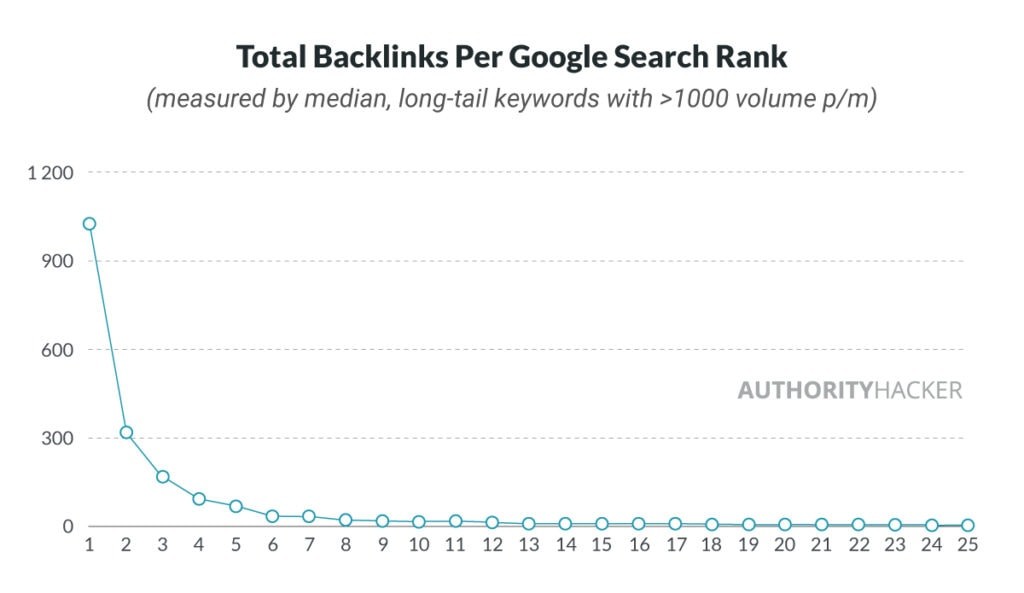
So that’s for links from other websites – different study, different dataset, results confirmed.
But what about internal links? Do they matter at all?
We’ve done a new study, so in this article, we’ll give you the answer.
You’ll also gain a thorough understanding of internal linking so when you’re done with this blog you can go on and take some immediate action.
Let’s do this.
What Are Internal Links?
An internal link is any kind of link on your website that links to another page on your website.
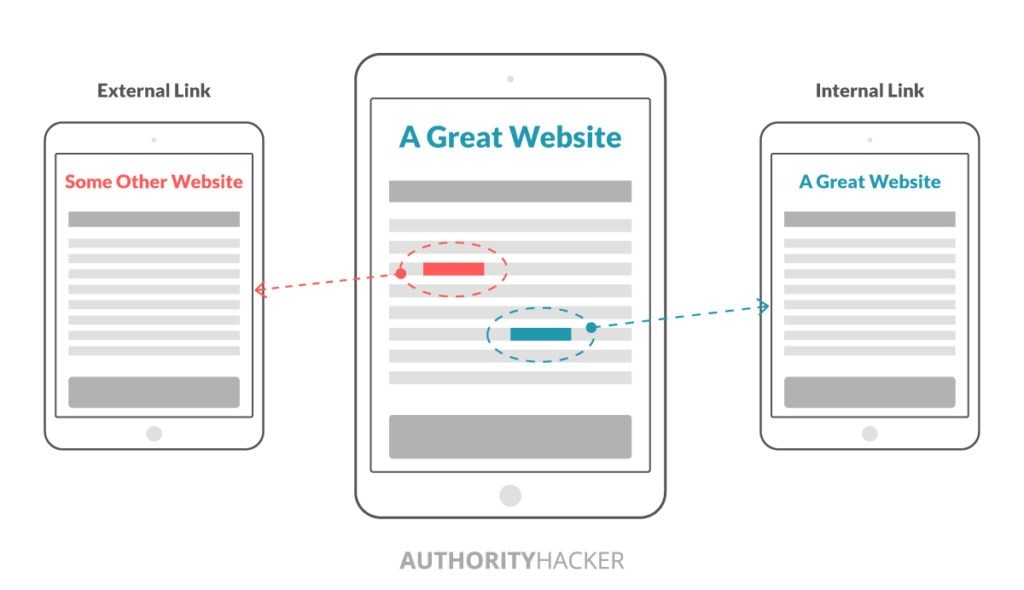
Internal links are not just links within the readable text, they include all links that point to other pages of your website.
That includes navigation links, CTAs, links in widgets such as “recommended articles,” image links and so on.
Another key term that we use a lot is “backlink”. There are external and internal backlinks and they refer to links on other pages and websites pointing back to your page.
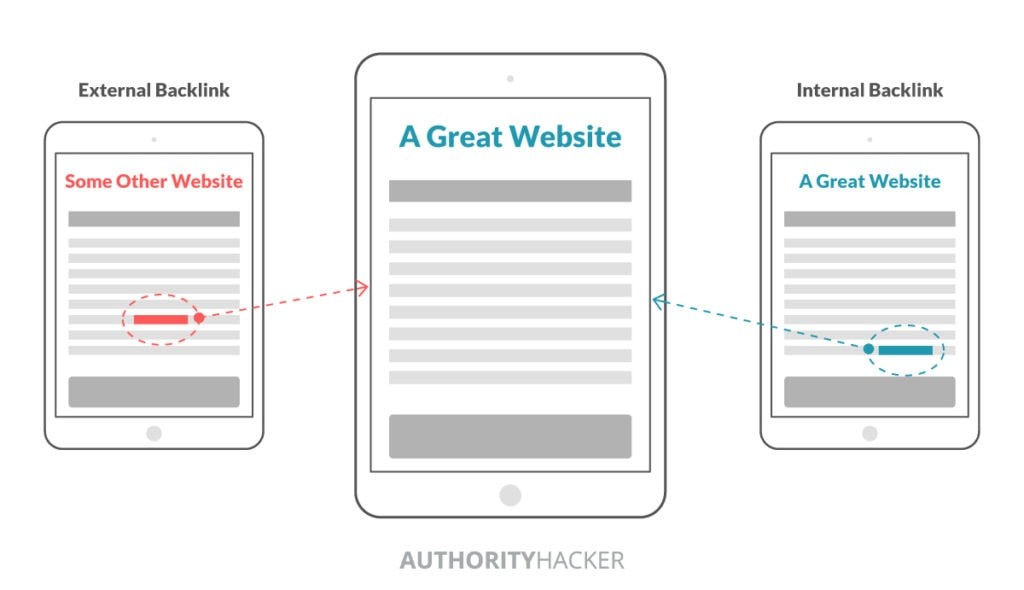
As already pointed out, external backlinks play a pivotal role in getting your pages rank high up in the Google results.
But when it comes to marketing, internal links are very useful too. In general, they fulfil three key functions. They help with SEO, user experience and conversion.
- SEO: Internal links help search engines better understand your website. They help them index your pages better and assign authority too.
- User Experience: A well designed link structure helps users meet their objectives. For example, to navigate easily, discover more of the relevant content.
- Conversion: These are links within your CTAs. It can be a link in a banner, in a signup button, or a text link pointing to a lead magnet.
It’s very useful to think about internal links in terms of these three categories, as each of them helps you with the most vital marketing objectives.
Namely, traffic (SEO), pageviews and CTR (user experience), conversion rates and revenue (conversion). In other words, each step of the conversion funnel.
This helps you create a very simple mental map that will make all of your internal linking work much more productive.

So, when you’re doing your internal linking work, don’t only think about SEO, you must also think about how to place links so they naturally align with your user’s goals and your own conversion goals.
Here’s why it’s important, and this is my opinion:
I believe, internal links are very important for SEO, but they are not the most important factor. Relevant external backlinks and quality, optimized content carry most of the weight when it comes to ranking.
Neglecting other useful functions of internal links may actually undermine your SEO efforts as good UX leads to more engagement and that leads to more backlinks.
Internal Links and SEO: What’s the Theory?
As far as I know, there hasn’t been any studies done on internal backlinks.
Most of what’s known comes hands-on (anecdotal) experience and a bunch of knowledge coming directly from Google some 6-7 years ago.
However, it’s quite an established fact that improving your internal link structure will boost your rankings in Google.
You’ll find plenty of articles, but no need for it, we’ve asked this question in our Facebook group to get some first-hand references:
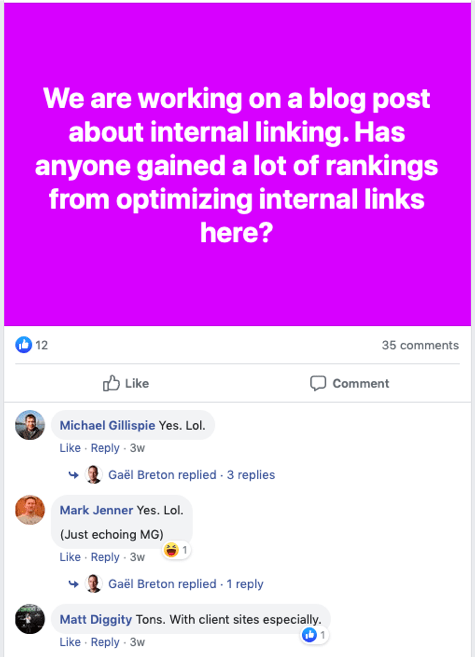
There’s a bunch of more detailed answers and we’ll outline some later. To make a point, however, here are some of the interesting ones.
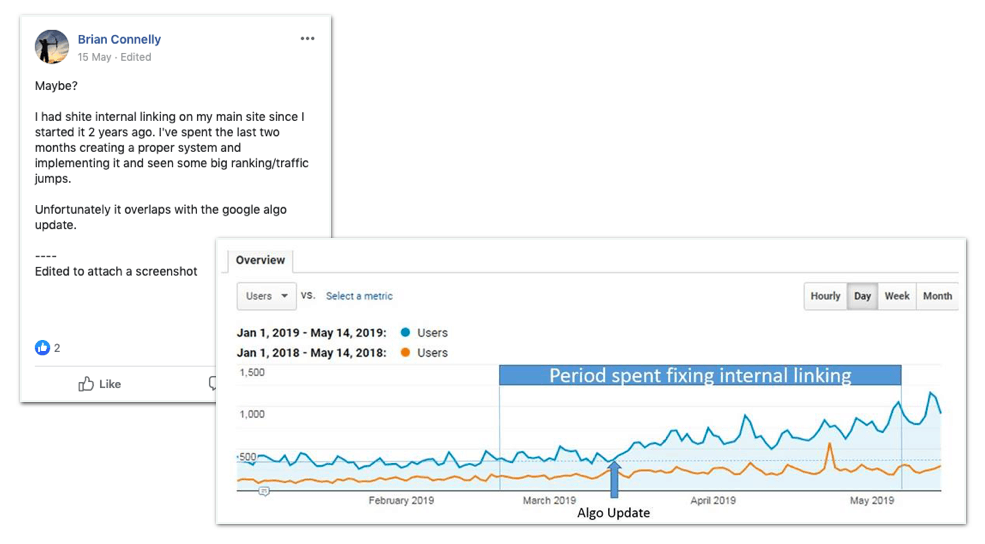
And another one with a screenshot:

So that’s for some evidence. People know internal links play a role in Google’s algorithm (or so it seems) and for a very specific reason – Google said so.
It was also clear from their original PageRank algorithm which is public, and has obviously evolved into quite a different animal since.
In general, most of the stuff that you read about SEO comes from either:
- Early days Google: In the early days the algorithm was simple and Google, stuff was easier to figure out and Google was a bit more open about it too.
- Latter days filed patents: Google files a tons of patents, some are never used. It opens room for speculation.
- Matt Cutts: Head of web spam at Google, who liked to blog a lot and implemented some big changes to Google’s search engine. He left Google at the end of 2016.
- Personal experience: Obviously, people figure out what works and what doesn’t based on doing things and trying out new stuff.
- Studies: Quite a few studies were done in this space, including our own Featured Snippets and Search Ranking Factors studies.
My point is, a lot of what we’re going to discuss here, may or may not be outdated. We’ve got some fresh data for you but first we’ll dive into all that theory so you get the picture.
There’s Google’s original algorithm, PageRank.
The way Google ranked pages was that each page was assigned an authority score and with each link some of that authority would get distributed.
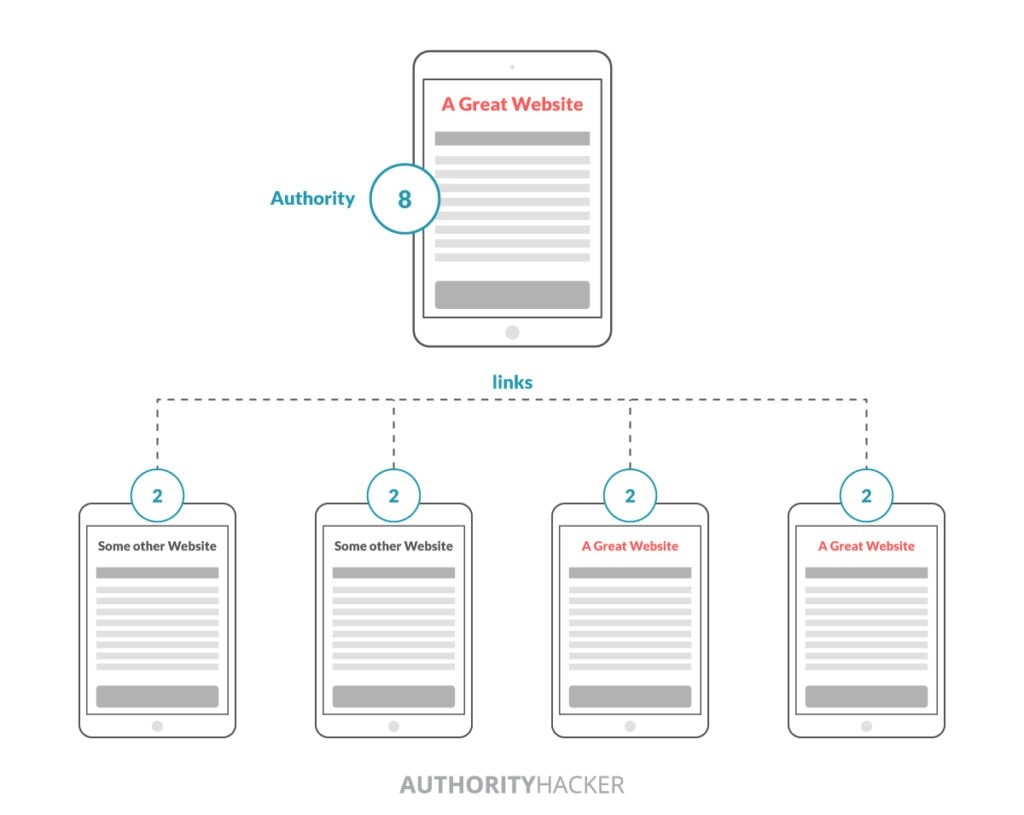
People were naturally abusing it so Google rolled out some updates, like link decay, and also, the algorithm evolved to factor other things in. Here’s what Matt Cutts said 10 years ago:
“Even when I joined the company in 2000, Google was doing more sophisticated link computation than you would observe from the classic PageRank papers. If you believe that Google stopped innovating in link analysis, that’s a flawed assumption. Although we still refer to it as PageRank, Google’s ability to compute reputation based on links has advanced considerably over the years.”
Sometime in between, it was possible to play around with authority using nofollow tags on your links which would make Google ignore the link and not transfer any score to that link, leaving more “juice” i.e. authority for the rest.
This was called pagerank sculpting.
Somehow that didn’t go very well with Google’s advertising objectives so the change was rolled back, in a sense that nofollow links are assigned score too but it doesn’t get transferred.
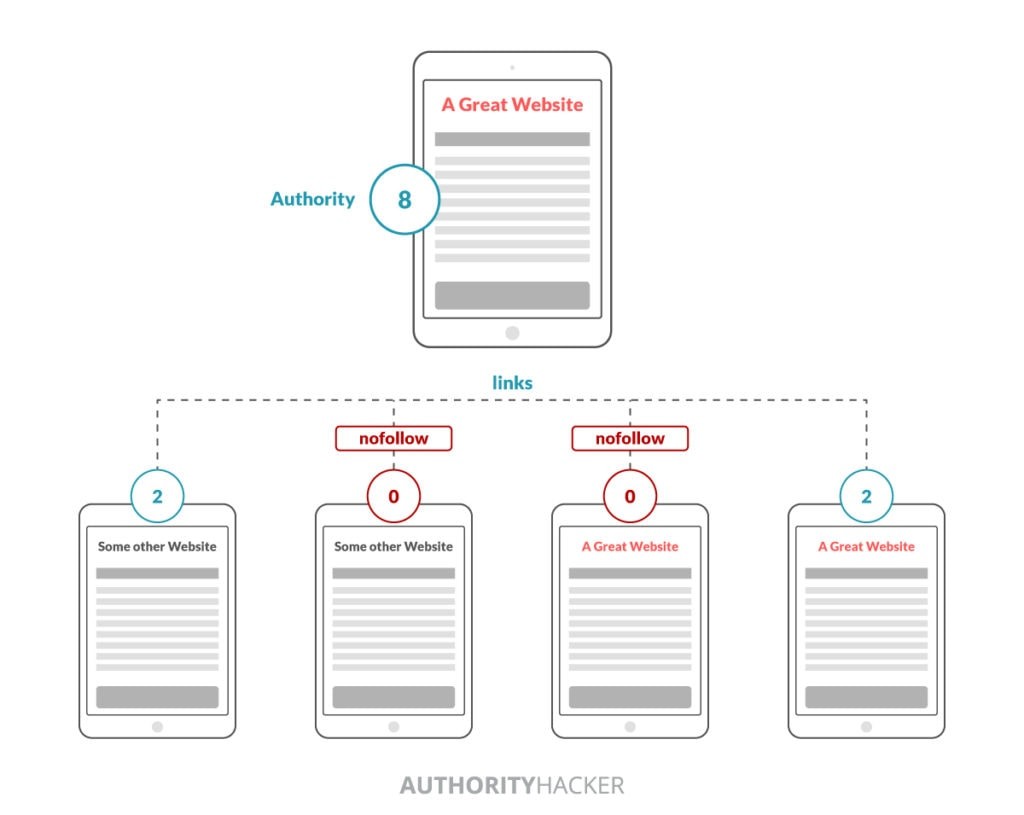
In general, the consensus now is that you should interlink naturally to let the “juice” flow freely. Apparently, PageRank still exists within Google’s algorithm but only as a tiny fraction of it.
Now here’s another thing. Anchor texts.
Some people believe they don’t play a big role anymore, and some think otherwise, mainly because Google actually says so.

It is also believed that Google that with so many websites to crawl only cares about anchor text of the first internal link inside the referring page.
That’s because there’s a patent filed by Google that describes such methodology, although it’s unclear whether it has ever been implemented at all – Google files a lot of patents.
Finally, a big piece of the theory is that your link structure should be very straightforward, as there’s “crawl budget” i.e. a time limit Google has to crawl a website.

So if your linked content is hidden down in a long chain of links, it may never get discovered.
Whether that’s true or not is irrelevant because the fact remains that Google has to crawl websites so you do want to make your website easy and simple for it.
From that, came out the practice of “siloing” (on that later) and cleaning up your links, mainly redirects and links pointing 404 error pages.
I don’t want to bother you with more theory. Especially because we have extensively written about it in our site architecture blog post.
Most of the stuff that SEOs do when it comes to internal links is somehow related to the above, and it seems to work well.
For example, here’s another reference from our friend Matt Diggity in the group:
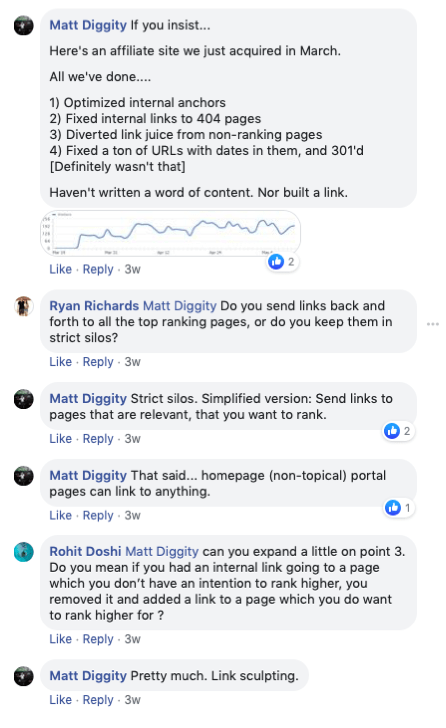
So basically, Matt acquired this site in March and all he did was fixing internal links. He hasn’t acquired any external backlinks nor added any content. Here’s a closer look at the chart:

In summary he did 4 things:
- Optimized internal anchors
- Improved the “juice” flow by fixing links pointing to the 404 page
- Created “silos”
- Made non-ranking pages link to the pages he wanted to rank better
Impressive. Now let’s dive into some details and data.
Internal Linking for SEO: what studying over 1 million links says
In this section we’ll look at some of the SEO community’s best practices, that are generally known to work and run data against them to see if they are indeed helping with rankings.
We’ve done some original studies too, to make it more interesting.
We worked with 2 datasets. A 500k SERPs for 5000 long tail, high volume (1000> searches a month keywords). For this we obtained link and backlink metrics using Ahrefs API.
Another one is a 10k URLs ranking on the first page of Google. We obtained 1 million internal backlinks for these, including anchor texts, metrics and URLs that we scrapped for additional data. 10k is not a huge dataset, so some charts are not so “smooth.”
To learn more about this research, here’s a link to our study methods.
1. Do internal links Actually help with ranking higher?
We already know that the number of external backlinks is pivotal to ranking high in Google.
That’s perfectly sensible as a link from another website represents an independent vote of authority. The question is, does the number of internal backlinks works in a similar way.
Looking at the sheer number of internal backlinks we found no correlation.

However, this is hard to measure because if you look at all the links pointing to a page, the crawlers are likely to collect a lot of garbage links, such as:
- website.com/article/comments/page2
- website.com/article/comments/page3
- and so on …
It’s quite hard to filter those out. When you use Ahrefs (review) for internal link analysis, they choose to deal with this by grouping links by the same anchor and surrounding text.

This, in my opinion, is far from an optimal solution because you’ll end up throwing a bunch of unique links into the same bucket, but Ahrefs does a good job at it most of the time. And the results provide a different, (perhaps a more accurate) picture.

As you can see, it somewhat correlates and quite nicely.
That can either mean that the top ranked pages have more internal backlinks, or that they use a greater variety of anchor text.
What’s more important, however, is to validate whether these links actually transfer authority to the pages they link to.
That’s the next thing we looked at.
So we looked at the number of referring domains to the pages that distribute these internal links. We also look at URL Rating which is Ahref’s version of pagerank.
It turns out both correlate nicely, the URL rating and the number of referring domains. Here’s the average number of referring domains per page sending the internal backlink.
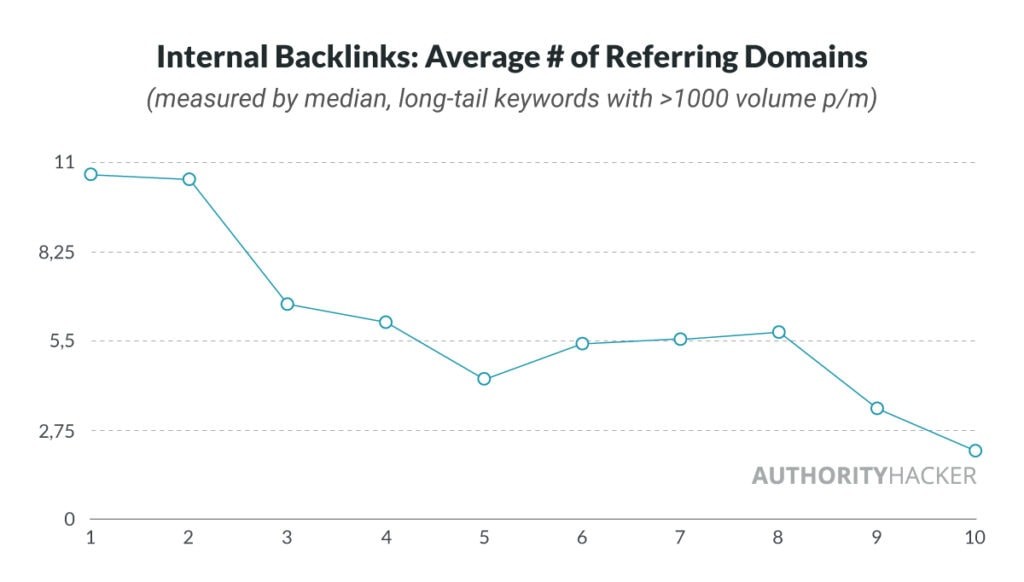
To synthetize these findings, we multiplied both the number of internal links and the links pointing to the pages sending internal links to the ranking page.
This gave us this new “Authority” metric that shows how internal links are an excellent way to channel external link authority to strategic parts of your site.
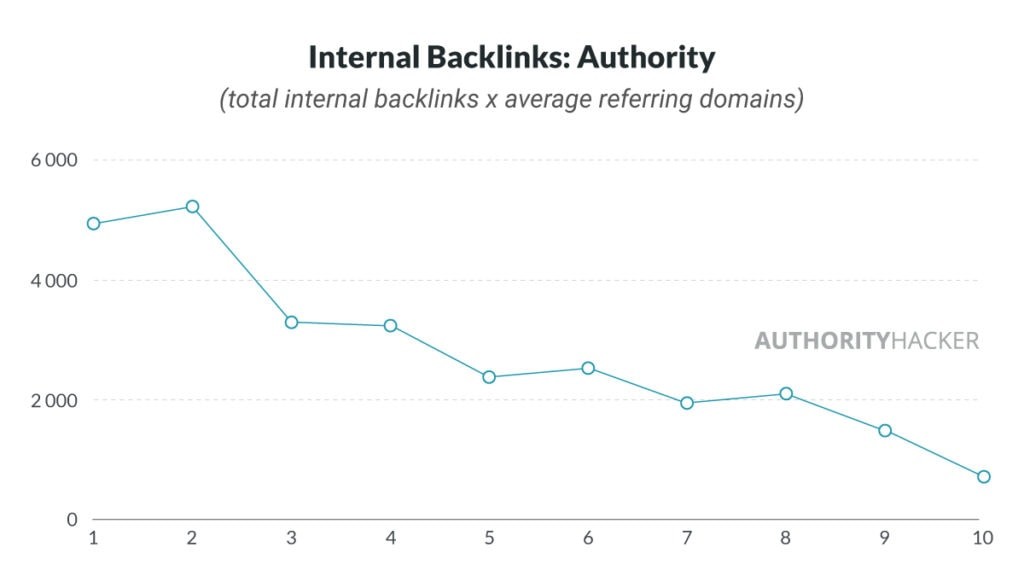
The excellent correlation shows that a strong internal linking structure from pages that get a lot of external links to pages you want to see rank higher is an effective SEO tactic which is exciting for those of you who use Shotgun Skyscraper ;).
I consider this result a solid piece of data.
I would just like to add that the median values show the same result. (I opted to show averages to avoid multiplying by 0 as must internal backlinks have no referring domains).
Conclusion:
Top ranked pages not only have a lot of internal backlinks, but these internal links come from pages that have collected a fair amount of external links themselves.
What this means in practical terms for authority site builders is that the tactic of building “link bait” content and then linking from that content to your “money” content absolutely works.
We have both experienced it in real life (see case study) and seen it in the numbers.
2. does internal link anchor text and surround text matter for Rankings?
It’s no news that Google cares more about relevance than any other technical factor. It is, at the end of the day, aiming to “to organize the world’s information” as it’s mission statement says.
Technologies like “natural language processing” still have a long way to go, and so it’s very likely Google mostly relies and basic bits of information like keywords, links and anchor texts.
For those who don’t know what an anchor text is, it is a readable part of a hyperlinked text. Here’s an explainer pic:

While I’ve seen SEOs suggest anchor texts don’t matter as much. Google and it’s employees seem to be of a different opinion.
So I took the keywords the URLs in our dataset rank for and compared them to all the anchor texts all of their internal links contained.
We measured the presence of some form of keyword, i.e. the partial match.
For example, with a keyword like “vegan protein” we would look at a presence of “vegan” and “protein” separately. An anchor text like “vegan sources of protein” would therefore provide a match.

Clearly the correlation is massive and anchor text in internal links is a huge deal.
Next, we crawled all the internal backlinks, pulled out the readable text of the pages the internal links cam from and searched for the presence of keywords in a similar fashion. Here are the results:
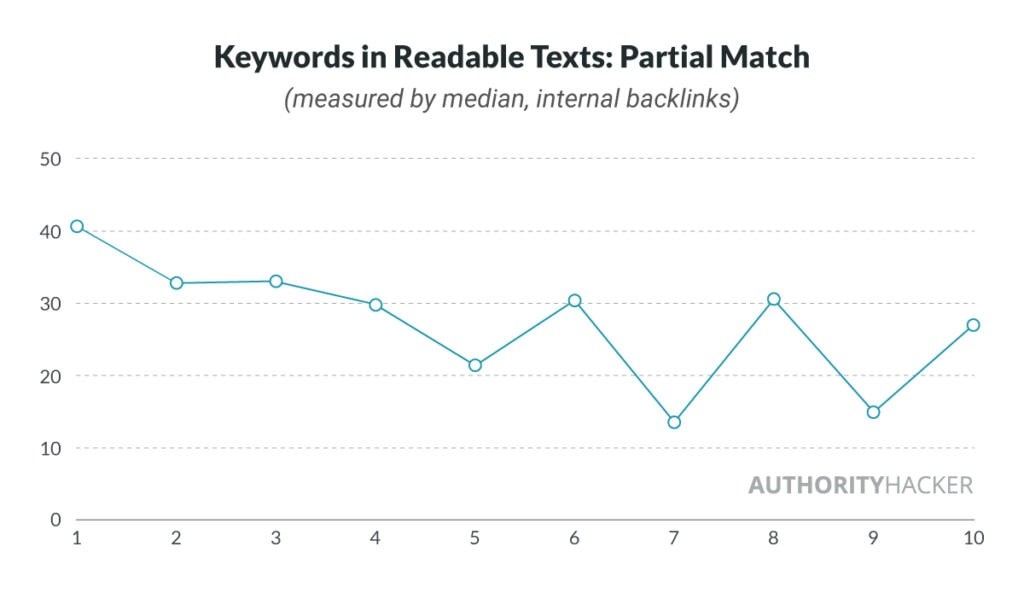
These charts are a little bit rough, so I don’t consider them to be a very strong evidence even if they show some correlation.
The crawler lost some 30% of all links due to various reasons like 503 and SSL errors.
However, the median figures that came out show some correlation even if it is not as strong as I would have liked
I would just add that having shown in the previous study, that keywords matter a lot, I wouldn’t be surprised if it so in this case too even if it was not obvious in this case.
3. what is the optimal internal link structure?
In the original PageRank paper, Google was compared to a random surfer. That is most likely still a valid analogy as Google crawls the web 24/7.
It uses internal links to discover pages and map the entire website. Obviously, the easier you make it for Google to crawl your website the better.
Google uses a crawl budget which is a time limit it has to discover and index all the pages it considers important. For small sites it’s not a big deal but for bigger ones it might be.
That’s why SEOs often recommend siloing as a way to build your website. We wrote an entire article on the topic of site architecture.
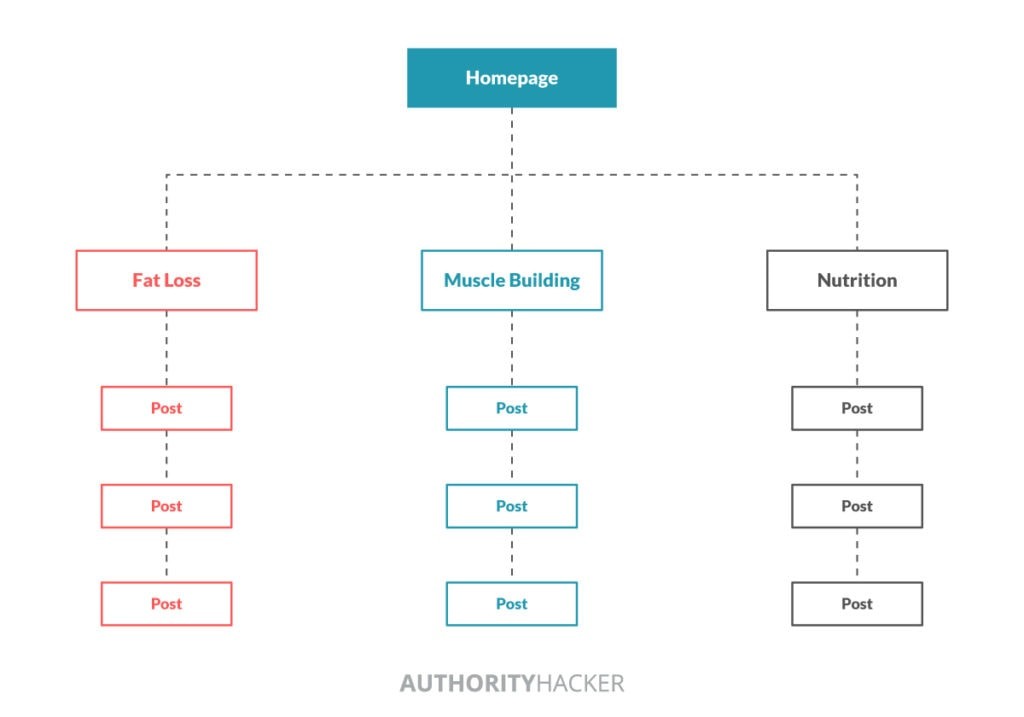
The basic idea is that you build up a flat architecture, divided into silos by topic and everything inside that silo links only to content of the same topic (silo).
There’s a bunch of benefits there. First, having links from the same section of a website makes it easy to convey both relevance and authority as silo looks like a mini-website.
We looked at the structure of the backlinking URLs and found that, the higher the rank the more likely they are to come from the same subsection or possibly a silo.
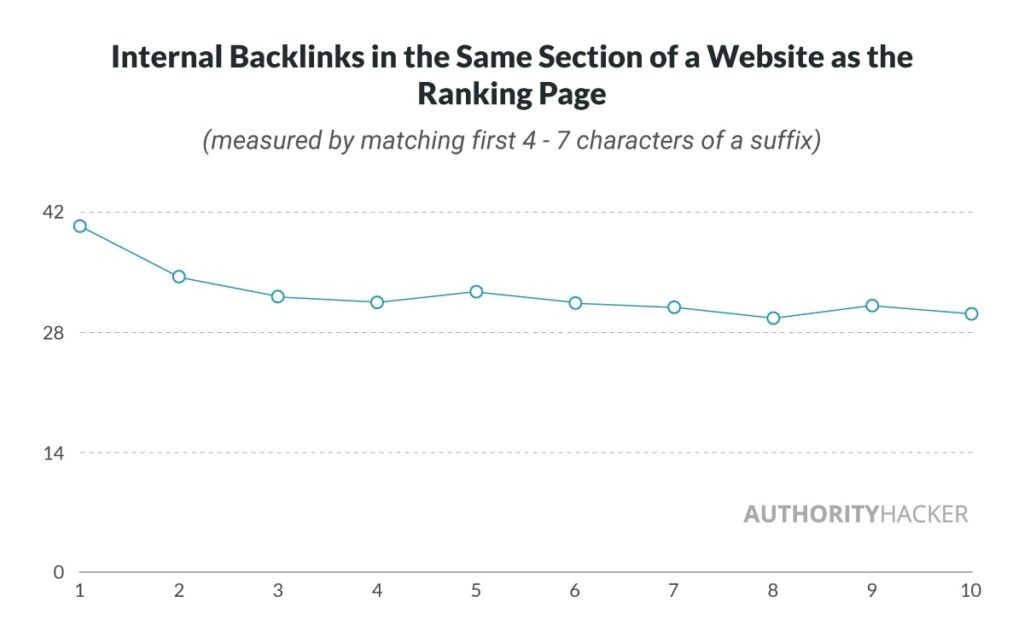
We did that by removing root domain from all links, then we looked at the remaining suffix and and let the algorithm compare the first 4 to 7 characters.
- www.website.com/bodybuilding/how-to-gain-muscle
- www.website.com/bodybuilding/how-bulk-efficiently
- www.website.com/diet/10-healthy-snacks
Another thing that’s commonly recommended by SEOs is to keep your top ranked pages as close to your homepage as possible.
It’s quite a popular practice, you can see, for example, backlinko seems to keep all of his articles in the /hub/ but the top performing ones are just below the homepage.
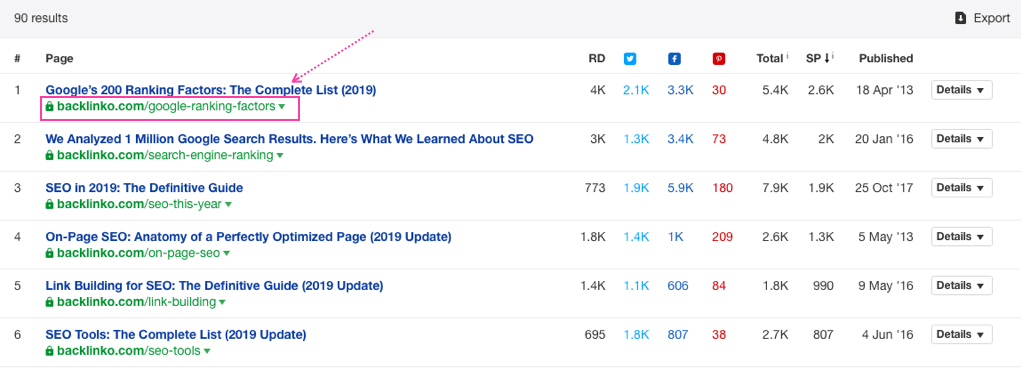
That’s because for most websites, the homepage is the URL with the highest authority. Google can easily identify it and likewise it probably gets most of the external and internal backlinks.
So when mapping a hierarchy of the pages, the ones which are closer to it, should be naturally perceived as more important.
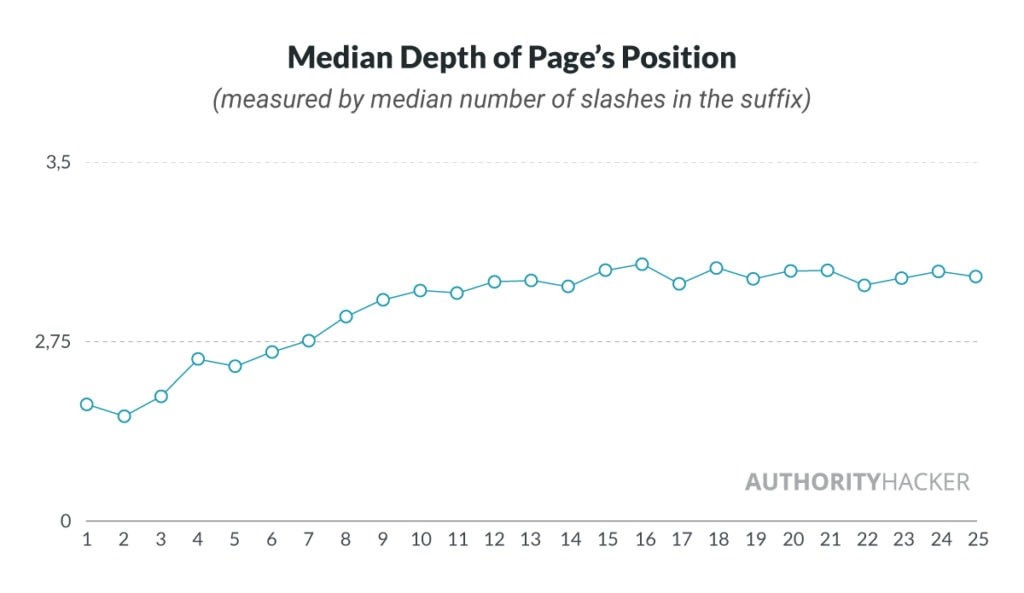
Here we simply looked at the number of slash symbols in the suffix of a root domain. No root domain URLs were present in our algorithm. We used a dataset of 500k URLs.
Clearly, higher ranked pages are closer to the homepage when compared with the rest. So positioning might be one of the many factors Google looks at.
Conclusion:
There’s a bunch of things that help Google crawl your site better. Speed matters, sitemap file, robots.txt … the list goes on.
As for site architecture in the context of internal linking, there is 2 ways of doing it.
- include categories in your urls, still try to keep them short and focus on intra-category internal links
- Put all your content just under your home page in terms of URLs and also focus on intra-category internal links.
Both approaches show positive ranking correlation provided scenario 1 has short enough URL’s.
4. How many Internal & External links should you use per page?
So much for internal backlinks. Now, let’s have a look at what’s a good number of links to fill your content with.
Luckily, Google provides an answer: “Limit the number of links on a page to a reasonable number (a few thousand at most).”
Simple right?
Obviously, I posted this as a joke. In general, nobody knows for sure. How’s few thousand a reasonable number?
Matt Cutts at one point stated that an optimal number is something around 100. But, again that’s 10 years ago.
The number of links includes all your navigation, footer, assets like images and similar stuff, external and internal links.
So hitting 100 or even a thousand isn’t entirely unimaginable.
I am not going to make any recommendations. But I had a look at the 500k SERPs dataset and was surprised to find a nice correlation from the top rank all the way down to the 100th.

So that’s internal links pointing to another page of the same website. These are the results we got after we kicked-out all the root domain results from the dataset.
The median number for the top rank is 85 internal links. And here’s a look at external links:
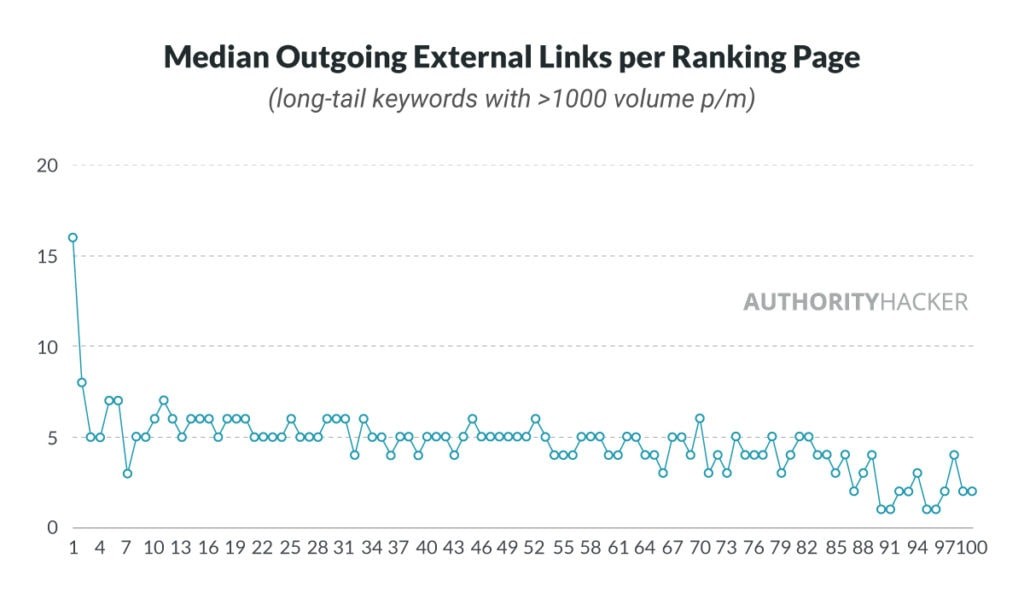
The median number for the top rank is 16 external links.
Note
I was surprised to see these results. In fact, I got them by accident when I confused a column in the dataframe. I did not expect the number of outgoing links to have any correlation with search ranks. But they came out nice and regular all the way down to rank 100.
Bear in mind the internal link number includes navigation, footer, content suggestions, images and so on. The actual number of URLs linking to another article may be closer to a single digit.
Also note that the higher ranked pages have typically longer content, as found in our SERPs study, so it leaves a little more space to feature more links.
Yet, the difference in numbers is way higher than the difference in word count.
Conclusion:
The more seems to be better, but it’s possible that too much will hurt your SEO. We don’t know, but we can rather safely assume 100 to be OK as advised by Matt Cutts.
What’s clear is that you should keep a link-light footer and navigations so you don’t make the entire structure overly complicated, and keep more room for links with SEO value.
Step-by-Step Guide: How to Optimize Your Internal Links
Here’s the part where we get actionable.
I would just like to remind you to not neglect user experience when doing this. So please, don’t just throw internal links that make no sense in your content.
In the end, Google cares about useful links and other metrics that result from great experience, possibly even more than mere quantity of links and anchor texts.
1. Redirect link juice to low hanging fruit pages
When getting started with internal linking, it is important to understand that all you have to play with is your existing incoming “link juice” to distribute accross a limited amount of pages.
For that reason, you will need to make decisions. What is the best use of the limited link authority you have to distribute?
To find the highest opportunities, use Ahref’s organic keyword report and look for juicy keywords that are at the bottom of page 1 or top of page 2

In the case of authority hacker, these 3 keywords seem particularly juicy and could easily be pushed up with some internal links from pages with a lot of external links.
The next step of the process is to find the pages that can link to these.
As we saw in the data part of this article, links from pages with external links are the most valuable. If they can also be in the same category, we give them some brownie points.
My favorite way of finding these pages is to install the ahrefs chrome extension and perform the following advanced query:
Site:yoursite.com “related keyword”.
In our example, that would be site:authorityhacker.com “travel”
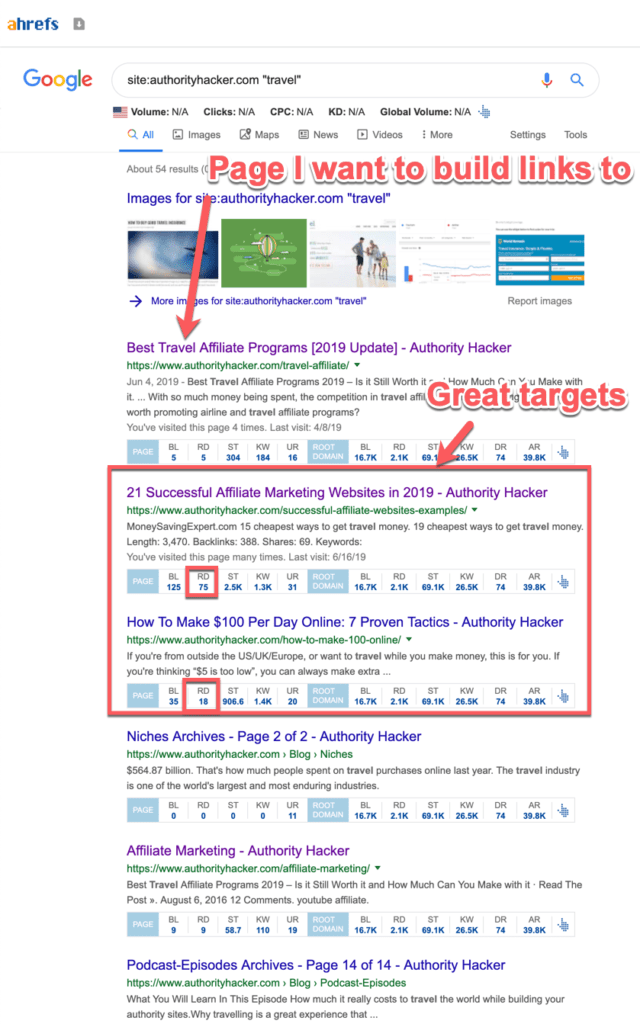
As you can see, Google is giving me a list of relevant pages on the site and Ahrefs is giving the link data of each page, so I can determine how strong the internal links will be in each case.
In this case, these 2 pages are perfect, they are both in the same category as my target page and receive a fair amount of external links.
You can run multiple keyword variations to find more matches,
Once you have identified the pages, simply review the copy and add the links where it feels the most relevant.
2. Improve your site architecture
Google will crawl your website and it will follow internal links to discover all pages. Therefore, you want your structure to be pretty straightforward.
At the same time, it shouldn’t be entirely flat because that won’t communicate the hierarchy of importance of each particular page.
In general we recommend something along the lines of creating silos. Here’s an entire post on the topic of siloing, including a step-by-step tutorial in the end.

There’s two things you want to do here. First, create category pages. Just like AuthorityHacker has – SEO, Affiliate, WordPress, etc. (We use Archive Builder by Elementor for that.)
Not only are all the articles in each category grouped by relevance which gives context to Google, but we also use single page category pages so you avoid diluting the link equity with pagination.
If a category gets over 100 articles (hasn’t happened yet on Authority Hacker), then just make single pages sub categories linked from the top of the main category page.
For example, in the case of the SEO category, make “keyword research” or “link building” sub categories to avoid overloading hub pages.

The second thing I’d recommend here, is keeping your top posts just one click away from the homepage. We do that at AuthorityHacker too.
That’s because your homepage is usually the page of your website that gets the most links.
So cutting the category page means these posts will get more link equity than the posts that are only on category pages.
It’s a nice little easy boost, especially if you have a decent level of incoming links to your site.
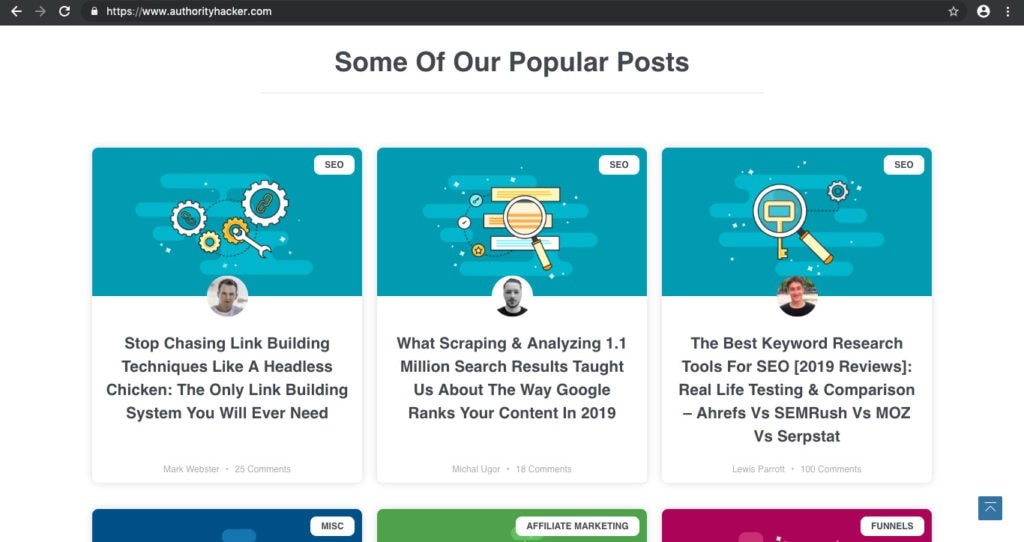
One way to maximize the links from your home page is also to reduce navigation. Keep top level navigation to a minimum, cut footer links you don’t need and avoid sidebars.
The more links you have on your page, the more you dilute the authority outflow.
Note
Obviously, this article is about internal links, so I won’t go into much detail but having too many external links may not be optimal, as you want to keep most authority within your website.
At the same time, you can’t have no external links because that is just dodgy.
So link to what’s most valuable and consider using nofollow tags for websites that aren’t likely to partner up with you – i.e. won’t ever return the backlinking favor.
3. Optimizing your anchor texts
First, you want to optimize your existing anchor texts. Simply head over to Ahrefs -> Internal Backlinks.
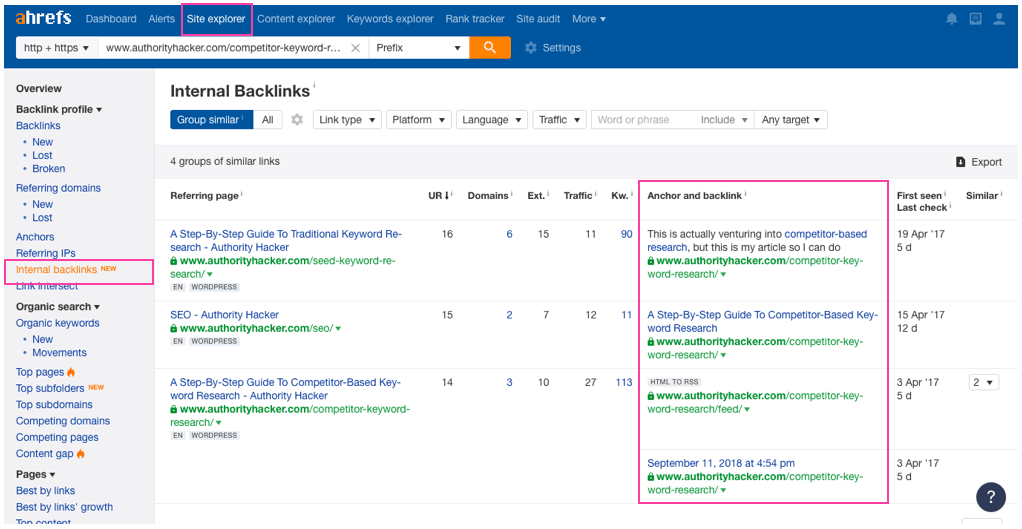
Here you’ll get a complete overview of the backlinking pages and the anchor texts in use. Now, you need to know which keyword you’re optimizing for.
If you’ve done your research on top pages, you should know the answer already.
In general, go with the highest-volume keyword (i.e. parent topic) you rank for, but keep an eye on other keywords too – for example, there may be long tail variations of the main keywords that can easily be captures that you may want to be using as anchor text.
You can go quite aggressive on keywords in internal links anchor text, a lot more than you would on external links.
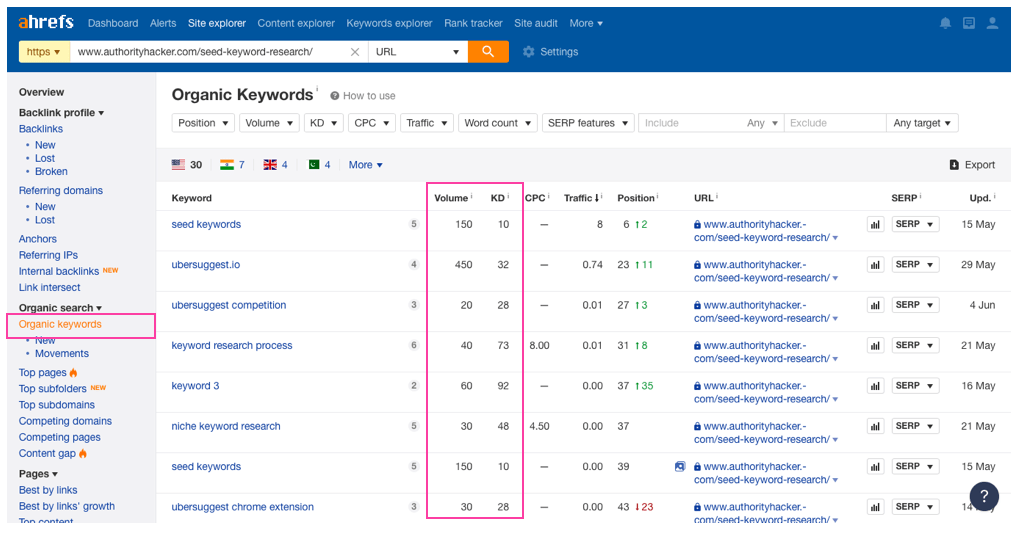
There’s also this idea I already mentioned that for same internal link Google only considers the anchor text of the highest positioned (first) link.
This has been voiced in the past, by the likes of Matt Cutts.
While we don’t know if this approach still exists in Google algorithm, we recommend that you treat it as a valid information, without ignoring other anchor texts too.
I’d also recommend to keep your anchor text varied and useful. Try to write them up as if explaining the contents of the link to a 5th grader.
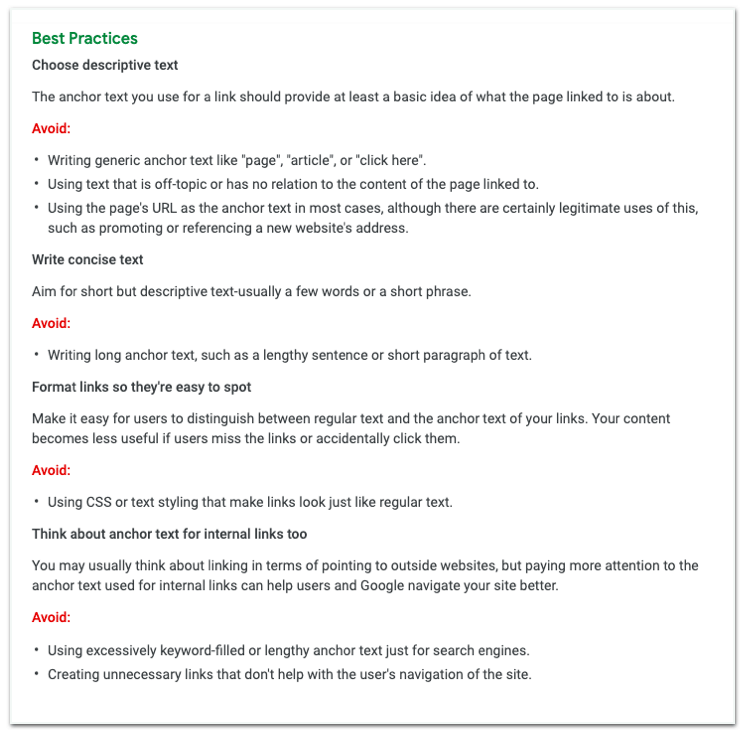
This is important. Google evaluates data programmatically, therefore the first match a typical algorithm will look for is the of the most simple structure.
For the new posts, you want to optimize anchor texts as you publish them, of course.
4. Recover links to 404 pages
This one is an incredibly simple one but every site I have audited had issue with it.
As time passes, you will remove content, merge content etc, and eventually, some of your external links will point to 404 pages.
Links to 404 pages basically do not count for your rankings.
So an easy way to get some more juicy links to your site today is to make sure no link points to 404 pages.
Luckily, Ahrefs has a handy report for that
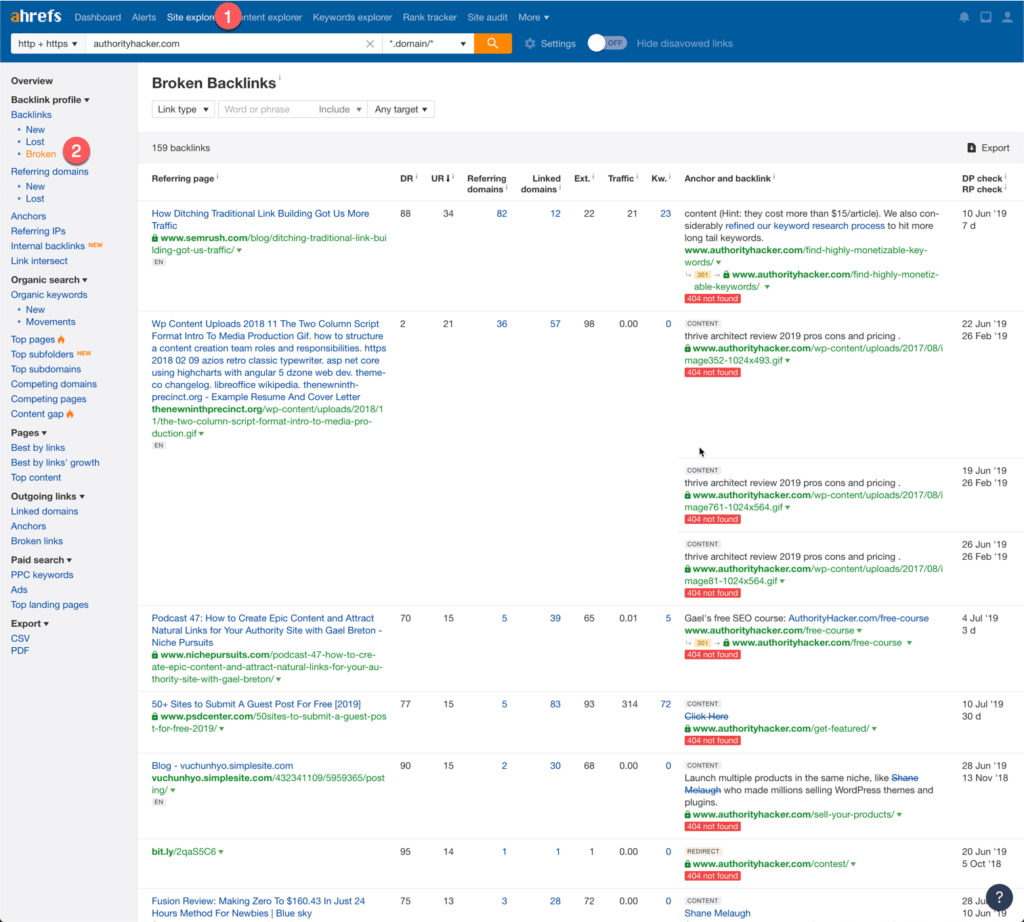
Once you have identified the broken links, simply use a plugin like redirection to point the url to the most relevant live url on your site

And voila, you have recovered some link equity in just 10 minutes. easy peasy.
Conclusion
This has been an interesting study for me to go through. And has it has revealed a lot of low hanging fruits on our sites while we were doing it.
The main takeaways from the data we analyzed is that:
- Internal links correlate highly with rankings.
- Linking out to other pages on your site also highly correlates with higher rankings.
- Anchor text matters for internal links, the more keyword rich, the better
- Links from pages with more external links improve rankings further than links from pages with fewer external links.
- Flat or siloed site structure work equally well provided your site’s internal linking structure is coherent.
We have also shown some easy ways for you to improve your internal link structure through quick site edits. I highly recommend you try them out and let us know in the comment section how they worked out for you ;).








